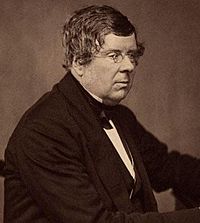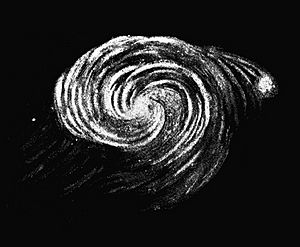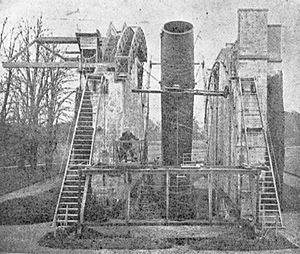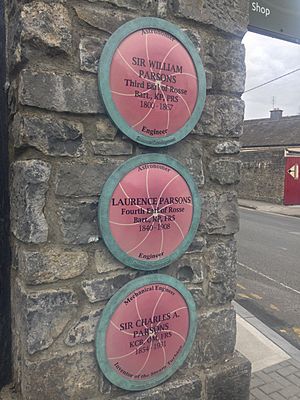William Parsons, 3rd Earl of Rosse facts for kids
Quick facts for kids
The Earl of Rosse
|
|
|---|---|

William, 3rd Earl of Rosse
|
|
| Born | 17 June 1800 York, England
|
| Died | 31 October 1867 (aged 67) |
| Known for | telescope |
| Awards | Royal Medal (1851) |
| Scientific career | |
| Fields | Astronomy |
| 27th President of the Royal Society | |
| In office 1848–1854 |
|
| Preceded by | Spencer Compton |
| Succeeded by | John Wrottesley |
William Parsons, 3rd Earl of Rosse (born June 17, 1800 – died October 31, 1867) was an amazing Irish scientist. He was an astronomer, a naturalist (someone who studies nature), and an engineer. He became the president of the Royal Society in the UK. This was the most important group for scientists in the 1800s.
Lord Rosse was famous for building huge telescopes. His most well-known telescope was 72 inches wide. It was built in 1845 and was nicknamed the "Leviathan of Parsonstown". This telescope was the biggest in the world for many years. It held this record until the early 1900s.
Contents
Early Life and Family
William Parsons was born in York, England. His father was Lawrence Parsons, who later became the 2nd Earl of Rosse. William went to college at Trinity College Dublin and Magdalen College, Oxford. He studied mathematics and finished with top grades in 1822.
In 1841, when his father passed away, William became the 3rd Earl of Rosse. He also took over a large family estate in Ireland.
On April 14, 1836, Lord Rosse married Mary Field. They had many children, but only four sons lived to be adults:
- Lawrence, 4th Earl of Rosse (1840 – 1908)
- The Rev. Randal Parsons (1848 – 1936)
- The Hon. Richard Clere Parsons (1851 – 1923), who was known for building railways in South America.
- The Hon. Sir Charles Algernon Parsons (1854 – 1931), who invented the important steam turbine.
Besides his science work, Lord Rosse was also involved in public life. He was a Member of Parliament (MP) and later became president of the Royal Society. He was also the chancellor of Trinity College Dublin.
Building the World's Largest Telescope
Lord Rosse is best known for building the "Leviathan of Parsonstown". This giant telescope was 72 inches (about 1.83 meters) wide. He built it at his home, Birr Castle, in Ireland. Before this, he had built a smaller 36-inch telescope.
Building the Leviathan was a huge challenge. Lord Rosse had to invent many new ways to build it. No one had ever made a telescope this big before. Other telescope builders kept their methods secret. He shared details about how he made the giant 3-ton mirror for the telescope in 1844.
The Leviathan telescope was seen as an amazing achievement in engineering. Pictures of it were shared widely. Building started in 1842, and it was first used in 1845. However, regular use was delayed for two years because of the Great Irish Famine.
Discoveries with the Leviathan
Using his powerful telescope, Lord Rosse studied and drew many nebulas. Nebulae are huge clouds of dust and gas in space. He was the first to see that some of these nebulae had a spiral shape. Today, we know these are actually spiral galaxies.
One of his most famous drawings was of M51, which is now called the "Whirlpool Galaxy". His drawing of it from 1845 looks very much like modern photos.

Lord Rosse also gave the Crab Nebula its name. He drew it with his older 36-inch telescope, and it looked like a crab. Even after he made a better drawing with the 72-inch telescope, the name stuck.
He also tried to figure out if nebulae were made of gas or tiny stars. He thought they were made of many small stars that his telescope could not fully separate. In 1845, he believed he had seen individual stars in the Orion nebula with the Leviathan. This was a big deal at the time. Later, other scientists like William Huggins used new tools to show that the Orion nebula was indeed made of gas.
Lord Rosse's son later published his father's discoveries. This included 226 new objects in space. These findings were shared in a book called Observations of Nebulae and Clusters of Stars Made With the Six-foot and Three-foot Reflectors at Birr Castle From the Year 1848 up to the Year 1878.
Lord Rosse's Telescopes
Lord Rosse built several reflecting telescopes. These telescopes used special mirrors made of polished metal to gather light.
Here are some of the telescopes he built:
- 15-inch (38 cm) telescope
- 24-inch (61 cm) telescope
- 36-inch (91 cm) telescope (also called the Rosse 3-foot telescope)
- 72-inch (180 cm) telescope (also called the Rosse 6-foot telescope or "Leviathan of Parsonstown"), which was finished in 1845.
Images for kids
See also
 In Spanish: William Parsons para niños
In Spanish: William Parsons para niños




